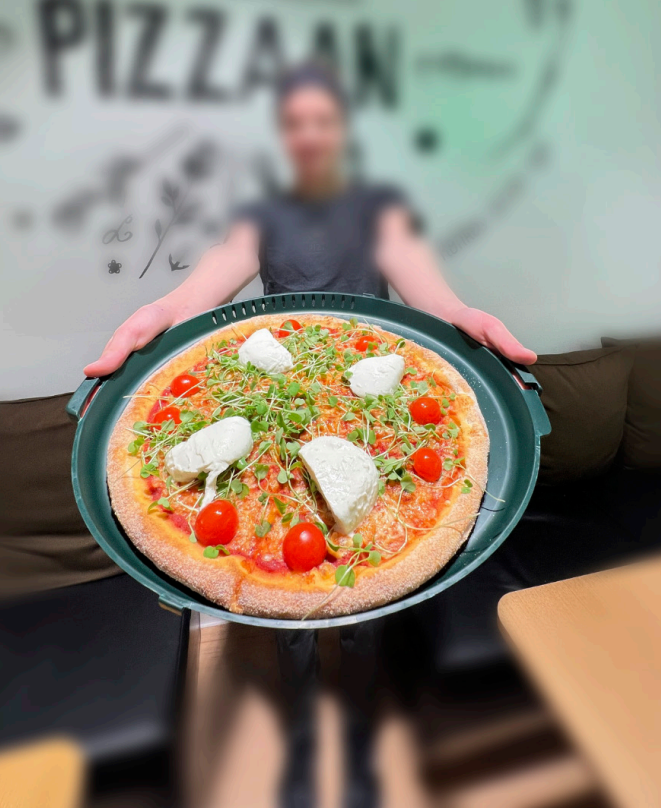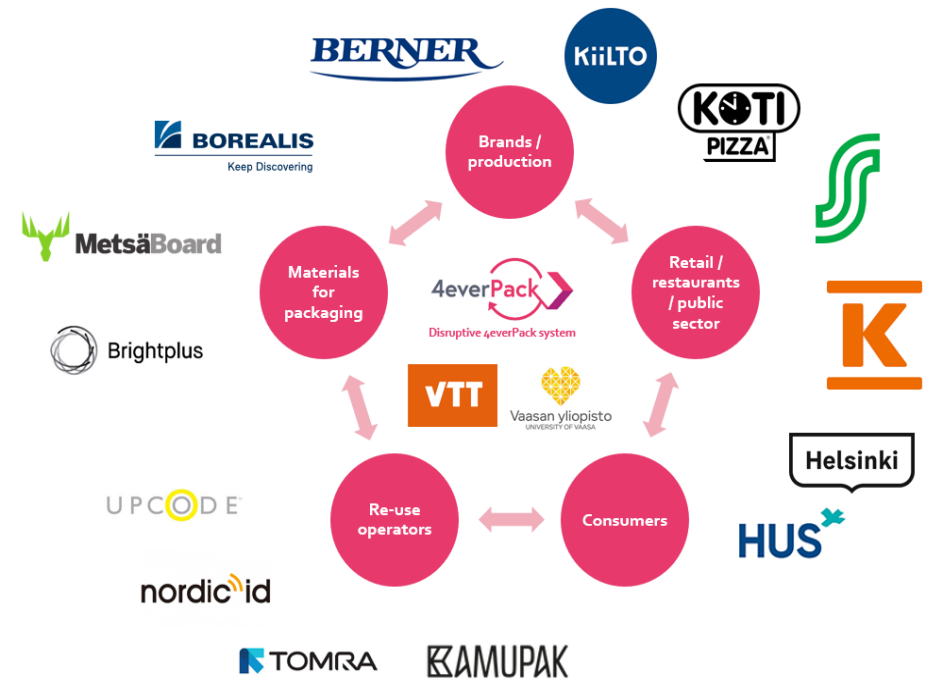
4everPack project generated important new understanding towards packaging reuse in fast moving consumer goods
Projects4everPack project was funded by Business Finland as a co-research project, with the project activities taking place between August 2021 and September 2023. The overall budget for the project was little over €1,5 million. The project concluded that the transition to reusable packaging systems has the potential to reduce the negative environmental impact of single-use packaging. 4everPack consortium identified several support mechanisms required for this transition including technological advancements, legislation, funding for innovation, increased consumer understanding and investments towards efficient reuse infrastructure.
The 4everPack consortium brought together researchers from both VTT Technical Research Centre of Finland and the University of Vaasa. 14 companies in total funded the project, participated in the project’s steering group, and actively contributed towards the project’s five use case demonstrations.

Figure 2. 4everPack Ecosystem. Source: Harlin, Ali ; Makkonen, Hannu ; Lahtinen, Jussi H. et al. / 4everPack: Final report. 2023. 125 p.
ExpandFibre team had the pleasure of interviewing the key team members of the 4everPack consortium to discuss the main achievements of the two-year research project and to reflect together on the required next steps to take the results of the project further. Henna Sundqvist (Senior Scientist at VTT), Kyösti Pennanen (Senior Researcher at University of Vaasa) and Sara Anttila (Sustainability Manager at Kotipizza Group Oy) kindly accepted the invitation to discuss the project and its outcomes.
Markku Leskelä, SVP Development at Metsä Board, also provided additional commentary on the 4everPack project: “In view of the recent ambitions of the packaging regulation, Metsä Board wanted to explore opportunities and challenges of the reuse concepts. Reuse has been a common application earlier, such as milk bottles in UK, but other packaging solutions are now dominating. Reuse represents a true circular concept as it must include, not only the manufacturing of the original material and the package, but also the collection of the used packages, treatments such as washing to return it into new cycle and the return itself into the packaging line. This may appear straightforward but there are several players involved and the business model must offer earning opportunities for them all. Overall, the 4everPack project offered a good platform to address Metsä Board’s targets.”
Highlights of the collaboration
Henna kicked off the discussion by explaining the fundamental motivation behind the project and its research – the constantly increasing amount of packaging waste generated globally by single-use packaging. Sara continued on the motivation for the project by stating that Kotipizza Group was very interested in joining the initiative, as general interest in circular economy practices and the evolving discourse surrounding it, had gained increasingly more momentum in recent years. What is more, the surge in take-away orders, especially increased by the COVID-19 pandemic, prompted the need to explore solutions for waste reduction even further.
Sara explained how pleasantly surprised she was by the end of the project as Kotipizza’s role within the consortium evolved to one of the five use case demonstrators with their reusable pizza box pilot developed in collaboration with Finnish circular economy start-up Kamupak. Sara explained: “At first we were thinking of possibly doing small-scale trials related to the plastic sauce bottles that are widely used in our kitchens, but our role grew to one of the five use cases with the reusable pizza box pilot. In 2022, we conducted a survey on reusable take-away packaging which attracted over 13 000 replies. 85 % of our survey replies stated that they were very interested in using reusable packaging for take-away pizza, especially for environmental reasons. In the end, we selected 40 pilot end-users from 12 000 volunteers for our reusable pizza box pilot”.
Kyösti elaborated on the use cases: ”In 4everPack, the research was built around the five use cases, including food and non-food reusable packaging, in which a portfolio of rapid experimentations were tested and implemented via surveys, interviews, field visits, pilot and prototyping. The use cases included the aforementioned reusable pizza box, reusable e-grocery packaging, reusable detergent packaging, reusable food packaging for hospitals and a reusable take away food packaging”.
According to Kyösti, Kotipizza’s use case was the most advanced of the five selected use cases: “In the other four use cases, the work concentrated on workshopping and active dialogue between the companies, which was of course also highly valuable”.
Kyösti also wanted to highlight the exceptional aspects of 4everPack in relation to prior research initiatives: “When preparing the project, we had a large number of industrial partners and companies that were highly interested in the topic of the project. The level of commitment that the company partners within the 4everPack consortium had, was on an exceptionally high level. For example, Kotipizza invested a lot of their own resources, including personnel and infrastructure, into their use case piloting. Other companies were equally committed, which really helped the project.” Henna also offered her thanks towards the companies and praised their active inputs in the co-creation workshops organized throughout the project’s duration.
Kyösti also offered a valuable glimpse into the consumer acceptance studies that were conducted internationally for the project: “Companies within 4everPack called for a more international point of view for the consumer studies, which was also valued from a research perspective, bringing more variation into the work. Thus, we selected Germany and UK as the international target markets for the consumer acceptance studies. The main finding of the consumer studies was that European consumers hold positive views, attitudes, and intentions toward reusable packaging and that consumers inherently associate reusable packaging with environmental sustainability.”
Kyösti noted that it was perhaps surprising that environmental value was not the main driver of consumer attitudes and intentions, as according to the study, affective factors including emotional value and emotions outweighed environmental values. Kyösti noted that this finding could impact future marketing of reuse solutions, as highlighting emotional and social meanings of reuse together with environmental sustainability might work as a key marketing argument for consumers.
Jointly identified challenges
The interviewees were asked to identify potential challenges from the two-year project. All three unanimously agreed that the piloting activities required a lot of resources – time, personnel, infrastructure, and money. Also, the chosen funding instrument was not suited to support the funding of piloting activities. Sara added that Kotipizza was surprised how much time and resources their own use case demonstration required, but ultimately it was extremely beneficial for the company going forward. Sara added: “With even more resources, we could have had an even more impactful piloting scheme around the theme of reusable packaging.”
Kyösti added that the relatively short two-year duration of the project was a challenge in general: “Prolonging the project by six months would have given us even more results. For example, the Work Package 5, Circular business models, could have really benefited from more time to reach concrete results and recommendations for future work.” Henna fully agreed with Kyösti’s assessment.
Final challenge was related to the sizable 4everPack consortium consisting of 14 companies in addition to VTT and University of Vaasa. Kyösti and Henna noted that universities, research organizations and companies worked very well together despite coming from various backgrounds and possessing very different ways of working. According to both, the research partners learned a lot from the companies and vice versa – throughout the project’s duration, the overall understanding of various partner needs grew exceptionally well despite the challenging starting point.
Next steps
As mentioned by Kyösti, the work related to circular business models did not reach all of its goals within the timeframe of the project, and the work around circular business models will be a theme area of great interest in future projects. Henna added: ”Ecosystem-like business model and its development is fundamentally important in advancing and developing the concept of reuse. We at VTT together with the University of Vaasa have prepared a continuation project for this specific theme area and are eagerly waiting for evaluation results. Managing of the ecosystem, developing the infrastructure around reuse, providing efficient logistics, as well as generating more consumer understanding are all important parts that need to be integrated to be successful in the future.”
Kyösti added that an EU project around the theme areas of recycling and reuse was recently launched in January 2024 with both University of Vaasa and VTT actively participating in the work. According to Kyösti, one of the key aspects of this EU project is to develop new methods for promoting reuse to consumers in addition to the established themes of environmental benefits and sustainability.
Finally, Sara added that Kotipizza is also preparing a plan to somehow continue the great efforts that were initiated within 4everPack, also including the important theme of logistics into their future work: “4everPack gave us a lot of courage and positive experiences to continue working on this theme also in the future.”
Main photo: Reusable pizza container piloted during 4everPack at Kotipizza’s Keljonkeskus restaurant in Jyväskylä, FIN. The reusable pizza box was supplied by Kamupak. Source: Kotipizza Group Sustainability Report 2022 (link).
More information: Click here to read about the 4everPack project at VTT’s research portal, including access to research outputs.